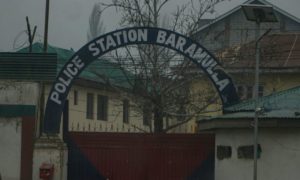It was midnight. They rushed with loud screams and moist eyes as they watched the local school raged with flames in the dark of the night. Residents of the village, barefoot, men, women, and children rushed from their homes with buckets of water.
Every tap was open. The mushroom smoke rising from the fire was a beacon of destruction, calling for salvation. They could save the brick walls of the school; the bricks that withstand thousands and thousands of Fahrenheits in kilns. The ceiling, though, was made of wood and turned to ash in the blink of an eye.
“Normal fires aren’t supposed to devour wood that fast.”
The benches and chairs were seared. The names and memories etched on the top and the sides of the wooden desks had evaporated with the smoke. The windows, wood and glass, were shattered, first with a blast of the incarnadine flames and then with efforts to extinguish the flames.
“It was weird,” a local who had tried to extinguish the flames, said. “We reached the spot very fast. We have had fires before, and never have they devoured the wood this fast.”
“Unless…” said his younger companion, when he was nudged on his side before he could finish what he had wanted to say.
The first fumes of smoke were seen by someone from the neighbourhood looking for a breath of fresh air. Wasting no time, he bellowed and shouted to anyone who was listening, and called for help, himself sprinting and stumbling towards the room on fire. New Lite School was on fire.
“There is a fire in the local school,” someone took to the mosque loudspeaker and announced.
The fire service arrived in no time. They broke a window in the classroom and sprayed the fire with extinguishers.
The floor carpet and the soft thermocol mats had been crumpled into a thick triangular heap pointing towards the ceiling. Like an umbilical cord, there was a rope pulling the heap and tying it to the wooden ceiling. The heap had been then put on fire, which was rising to the wooden ceiling above, through the rope that had been strategically placed there.
“The ground floor of the school is obviously more easily accessible than the floor above, but it has a concrete ceiling. The first floor of the school (which had been lit), however, has wooden ceilings,” Ghulam Ahmed Bhat, a 50 year old accountant of the school in Pattan, said.
The fire took a long time to extinguish. The continuous local efforts helped, but unfortunately, several people had injuries in their hands.
“All I could see was the gloom in the children’s eyes as in the beginning, the 5th grade classroom was set ablaze,” said Bashir Ahmad Dar, the headmaster of the New Lite School in Tapar, Pattan. “It takes us years to build a school; and makes a never ending impact on the minds of the children. When their second home (school) is burnt, they are never quite the same again.”
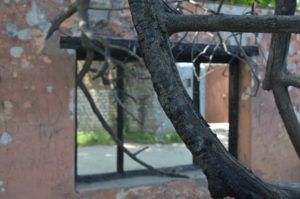
A classroom burnt, with a collapsed roof and burnt branches.
The school accommodates 430 students from the village of Pattan and is populated with children from its adjoining areas as well. This was one of the three schools therein Tapar which got partially damaged in the 2016 turmoil.
“An FIR has been lodged, but no compensation has been made so far to renovate the school to its original form” asserted Basher Ahmed Dar.
“We did not want to follow up the case. There are always great dangers involved when you follow something like this,” the headmaster adds, not specifying the dangers per se.
“The Deputy Superintendent of Police, Baramulla visited the school after the incident and directed us to reopen them immediately,” he says.
According to the reports of local newspapers, the schools were targeted by unknown persons in the aftermath of July 8, following the killing of Hizbul Mujahideen militant commander Burhan Wani in south Kashmir’s Tral area.
Around 32 schools have been targeted; eleven of them fully damaged, leaving the rest with partial damage.
Towards July end, the Government Boys School in Tapar in North Kashmir was one of the first schools set ablaze in fire in District Baramulla.
Tapar is some 40 odd kilometres away from the heart of city, Srinagar.
“It is not just the infrastructural integrity of the school that is compromised when it is burnt in times of conflict. No matter who does it, it leaves a scarring impact on us and the kids. I could not sleep for days. We spend more time here than we do at home. This is such a tragedy,” says a sceptic Shaheena Kausar, the headmistress of a boys Government middle school.
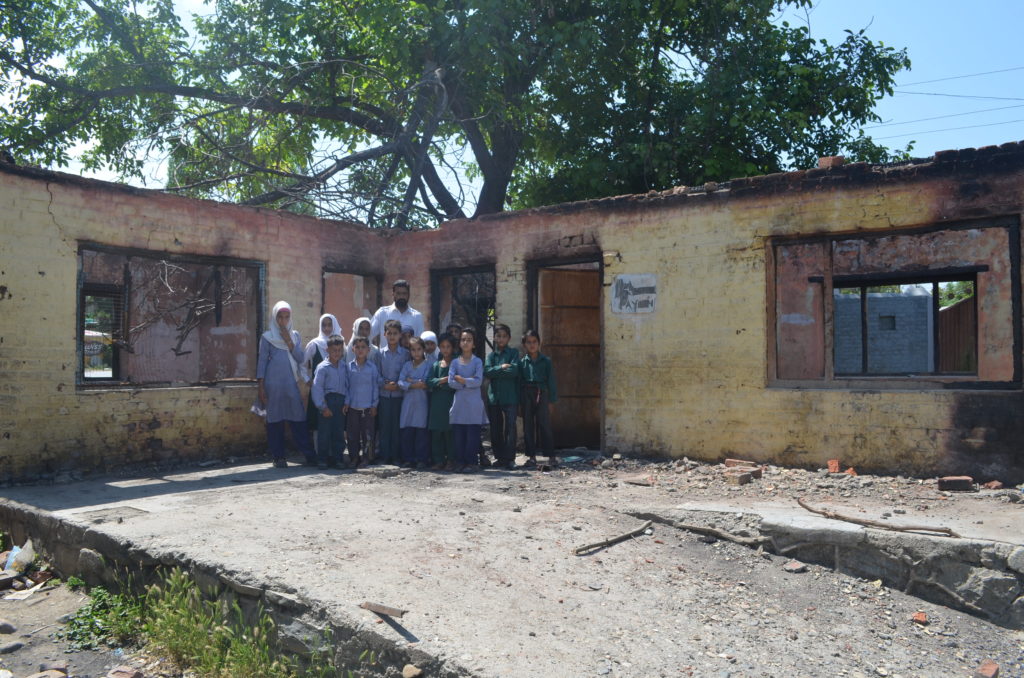
Students of the government school, Pattan, with a teacher
“To damage any school is a completely savage, primitive, and a heart-breaking thing to do. Schools are the collective properties of communities and students. Such unfortunate incidents set a profound impact upon us. The kids still ask me why the schools were burned. I still don’t have an answer for them,” she adds.
“They shouldn’t have destroyed schools, it’s our family.”
“The perpetrators of this arson, this burning of schools, haven’t been found. There is no saying who burned these schools. This whole enterprise is very shady, with no direct answers. Nobody has claimed responsibility for these attacks, either. There are no answers despite FIRs being lodged,” Shaheena says, asking her friends to get snacks for us.
“At the end of the day, we just hope to make a fresh start”
Each and every able-bodied local man, woman, and child of the village, tried to put out the flames, but the damage had been done.. All the documents of the school in that building, the books, and all the records of the students were reduced to ash.
Another school, not many kilometres from here, became a victim of an unfortunate fire episode.
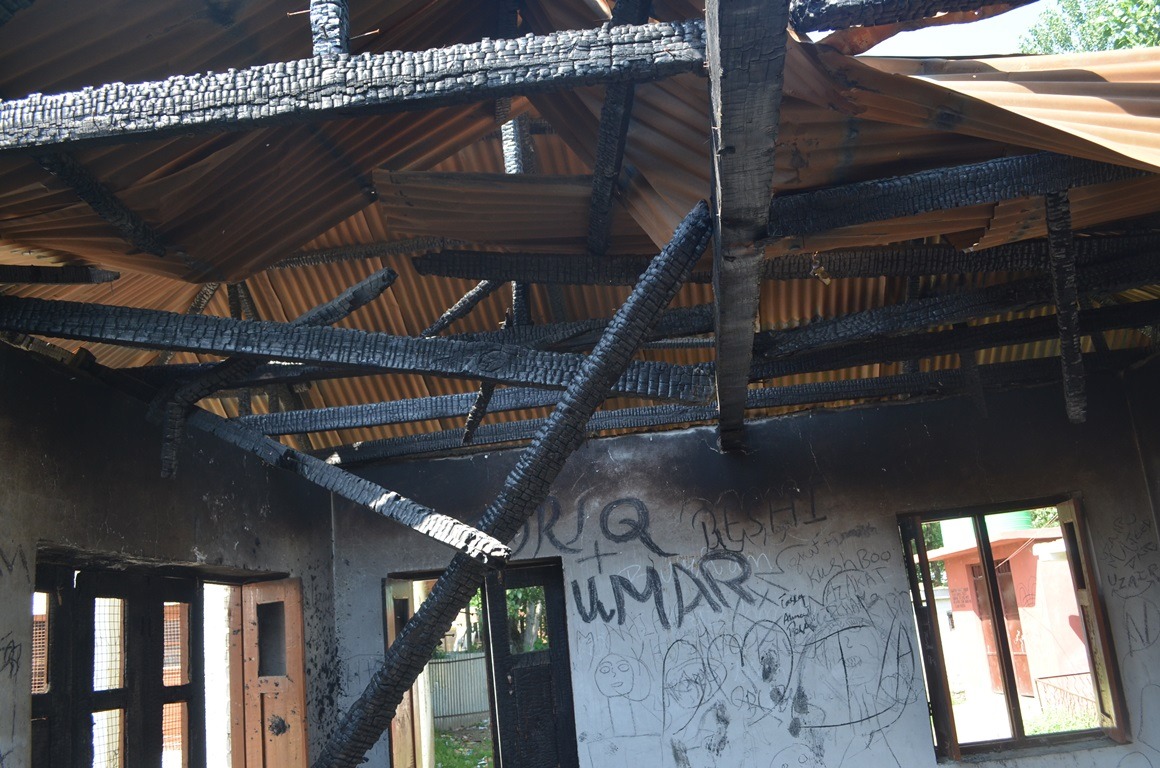
Insides of a classroom.
The government boys’ middle school in Palpora area of District Baramulla, which, defying its name, educates some girls too, narrates the same ordeal and presents a similar haunting story of a school being reduced to ash.
On the 9th of October, the school was closed because of a curfew. It had been closed for a while now, as a part of the long series of curfews that followed the killing of Burhan Wani, and civilians, at the hands of the Indian Armed Forces in the year 2016.
A one storey building stands out in this school complex. It is missing a roof, and has a brown tinge all over it, contrary to the white painted walls of every other building there. The door is missing, but there is enough debris inside to obstruct entry. Three broken columns form an asymmetric door. A peek through this crevice reveals a room filled with burnt lab equipment, and books; a lot of books.
Around 7:30 pm that day in October, the school was already up in towering flames, resulting in the complete incineration of this building.
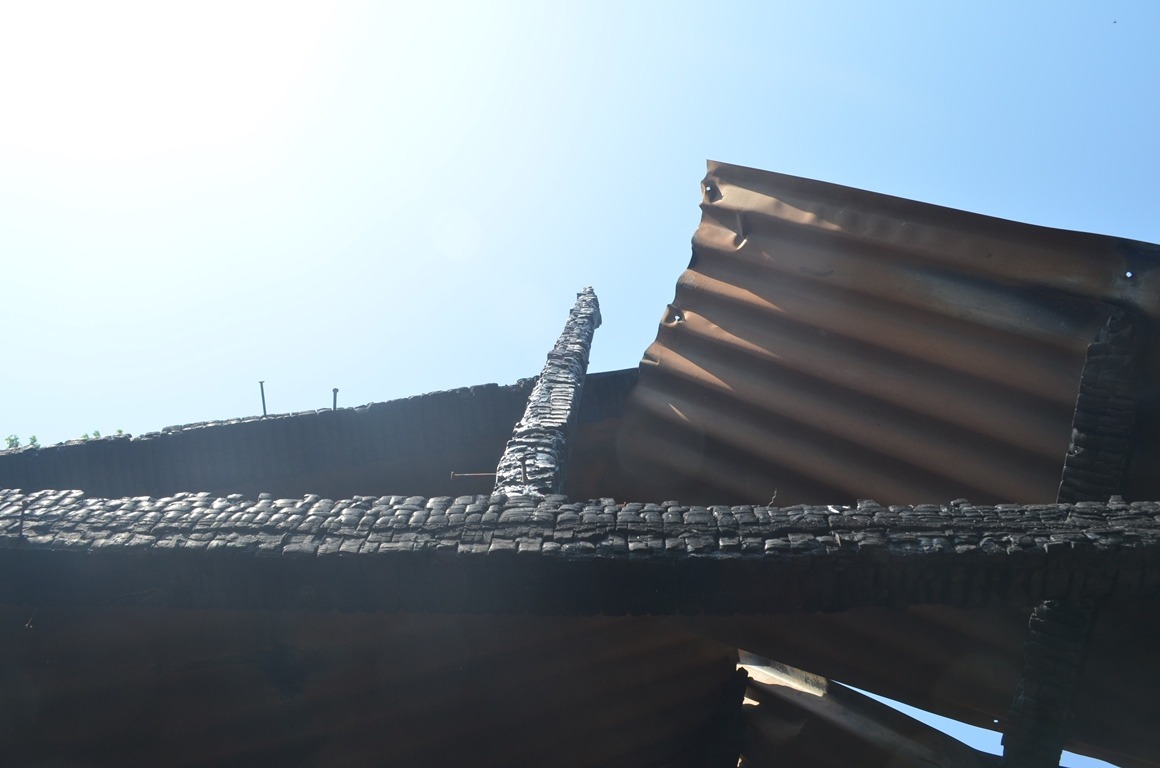
Ceiling, columns, and burnt beams inside a school.
Buckets of water were summoned again as in the neighbouring government school. Nothing could be saved. The fire had lasted its course. It wasn’t possible. Within half an hour, hundreds of wooden plies were burnt down to ashes.
Along with it, all of the books in the library, stacks of exercise books for the new session, laboratory materials, and sport items were destroyed.
The aftermath of the tragic fire episode has reduced the count of the students there.
“A primary school was clubbed with us. All of that school’s materials were also all burnt. Nothing could be saved,” Jhan Mohammad Dar says in a hopeless, brittle voice. Jhan is a senior teacher.

A lab which was charred in the fire.
“We don’t have a storeroom. No practical classes can be taken because of shortage of materials. Unavailability of classrooms has forced us to take two classes in one room, and that has hindered education,” he concludes.
At least 90 people have been killed, more than 12,000 others injured, including hundreds maimed and blinded by lead-based pellets fired by the Indian security forces to subdue one of the biggest protests in last twenty years.
The State government had issued orders for schools to be guarded. Still it has been unable to prevent the arson or even get close to those it insists are behind these unabated series of fires.
As a result of the curfew and the protests, most children had not attended school and over 5,000 students got affected adversely.
Most of the burnt schools are still in the same condition as they were one day after they were burnt. Classes, in many places, are still held out in the open. With winter closing just a few months away, the administration looks more concerned with the symbolic opening of the schools than their proper functioning.



